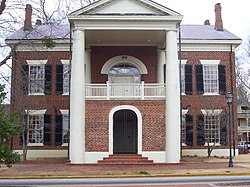Dahlonega, Georgia | |
|---|---|
City | |
 Historic Lumpkin County Courthouse, which now houses the Dahlonega Gold Museum Historic Site | |
| Nickname: Gold City | |
 Location in Lumpkin County and the state of Georgia | |
| Coordinates: 34°31′57″N 83°59′06″W / 34.53250°N 83.98500°W | |
| Country | United States |
| State | Georgia |
| County | Lumpkin |
| Government | |
| • Mayor | JoAnne Taylor |
| • City Manager | Allison Martin |
| • Chief of Police | George Albert |
| Area | |
| • Total | 8.87 sq mi (22.97 km2) |
| • Land | 8.82 sq mi (22.84 km2) |
| • Water | 0.05 sq mi (0.14 km2) |
| Elevation | 1,450 ft (442 m) |
| Population (2020) | |
| • Total | 7,537 |
| • Density | 854.83/sq mi (330.06/km2) |
| Time zone | UTC-5 (EST) |
| • Summer (DST) | UTC-4 (EDT) |
| ZIP codes | 30533, 30597 |
| Area code | 706 |
| FIPS code | 13-21240[2] |
| GNIS feature ID | 0355420[3] |
| Website | dahlonega-ga |


Dahlonega (/dəˈlɒnɪɡə/ də-LON-ig-ə) is the county seat of Lumpkin County, Georgia, United States.[4] As of the 2010 census, the city had a population of 5,242,[5] and in 2018 the population was estimated to be 6,884.[6]
Dahlonega is located at the north end of Georgia highway 400, a freeway which connects Dahlonega to Atlanta. Dahlonega was named as one of the best places to retire by the publication Real Estate Scorecard.[7]
Dahlonega was the site of the first major Gold Rush in the United States beginning in 1829. The Dahlonega Gold Museum Historic Site which is located in the middle of the public square, was originally built in 1836 as the Lumpkin County Courthouse. In 1849, when local gold miners were considering heading west to join the California Gold Rush, Dr. Matthew Fleming Stephenson, the assayer at the Dahlonega Branch Mint, tried to persuade miners to stay in Dahlonega. Standing on the courthouse balcony and pointing at the distant Findley Ridge, Dr. Stephenson was recalled in his speech as saying: "Why go to California? In yonder hill lies more riches than anyone ever dreamed of. There's millions in it," This phrase was repeated by those miners who did make the journey to California and was shared in the mining camps of the west. Years later, the young Samuel Clemens, better known as the author Mark Twain, also heard of Stephenson's phrase. Twain was so enthralled by the phrase "There's Millions In It," that he used it frequently in his book The Gilded Age. Over time, the phrase has been misquoted to the better-known "Thar's gold in them thar hills."[8][9]
- ^ "2020 U.S. Gazetteer Files". United States Census Bureau. Retrieved December 18, 2021.
- ^ "U.S. Census website". United States Census Bureau. Archived from the original on December 27, 1996. Retrieved January 31, 2008.
- ^ "US Board on Geographic Names". United States Geological Survey. October 25, 2007. Archived from the original on February 12, 2012. Retrieved January 31, 2008.
- ^ "Find a County". National Association of Counties. Archived from the original on May 31, 2011. Retrieved June 7, 2011.
- ^ "Profile of General Population and Housing Characteristics: 2010 Census Summary File 1 (DP-1), Dahlonega city, Georgia". American FactFinder. U.S. Census Bureau. Archived from the original on February 13, 2020. Retrieved December 18, 2019.
- ^ "Population and Housing Unit Estimates". Archived from the original on July 31, 2019. Retrieved June 4, 2019.
- ^ "Dahlonega, Georgia | Best Cities and Places to Live". Archived from the original on April 21, 2015. Retrieved May 3, 2015.
- ^ "Millions - Lumpkin County Historical Society". Archived from the original on September 27, 2016. Retrieved September 25, 2016.
- ^ ""Thar's Gold in Them Thar Hills": Gold and Gold Mining in Georgia, 1830s-1940s". Archived from the original on April 21, 2017. Retrieved September 25, 2016.

